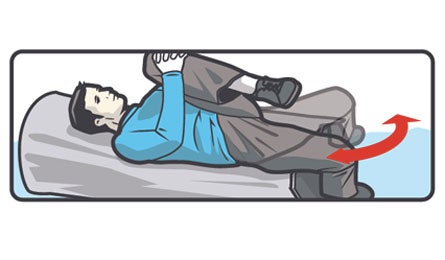Mileage Master Skills

'You can do this IT band stretch in the field. (Supercorn)'
Prevent High-Mileage Injuries
Stop these common ailments before they end your hike.
Issue: Dull or aching knee pain
Cause: Walking downhill causes small tears in the patellar tendon below the knee (called patellar tendinopathy). Patellofemoral Pain Syndrome is a result of excessive wear on the kneecap itself. Both lead to persistent aches and stiffness.
Solution: Rest and elevate the joint, ice it (if there’s no snow, submerge your leg in a cold creek), and take an anti-inflammatory (like ibuprofen) prophylactically and to manage pain. It may help to wear a brace and use trekking poles to reduce joint stress.
Issue: Pain and stiffness in the heel and bottom of the foot
Cause: An inward-rolling gait, high arches, flat feet, a tight Achilles tendon, and ill-fitting shoes can all strain the plantar fascia, the thick tissue on the bottom of the foot.
Solution: Rest, stretch your toes and calf at least three times a day, ice the bottom of your foot, and take an anti-inflammatory. Wear heel pads, cups, or custom orthotics in your boots.
Issue: Tenderness on the outside of the knee
Cause: Muscle imbalances exacerbated by an unevenly weighted pack, slanted terrain, or extended hiking can cause Iliotibial Band Syndrome, inflammation of the band that runs from knee to hip.
Solution: Rest, ice, elevate, and take an anti-inflammatory. Sleep with a pillow or padding between your knees (if you sleep on your side) to reduce pressure on the IT band. Stretch daily: Lie back on a flat surface so your affected leg hangs over the edge with a 90-degree bend in your knee. Pull your unaffected leg to your chest. Keep your hips level and move the thigh of your injured leg across your midline (without rotating it; see illustration above). Hold the stretch for 30 seconds and repeat four times. Consult a physical therapist; if pain isn’t persistent, you may be all right to continue.
Stay in Touch
Bring the right equipment (and power) to stay connected.
Upgrade for off-the-grid coverage
Transform your phone into a satellite communicator with DeLorme’s inReach for Smartphones app (startup $250; subscriptions $10/month; inreachdelorme.com); it allows two-way messaging with pole-to-pole coverage. Or, add SPOT Connect to your SPOT GPS tracker to send texts, emails, and Facebook and Twitter updates through your smartphone (startup: $170; subscriptions: $100/year; findmespot.com). If you’re going overseas, unlock your phone (check with your service provider; for a fee they’ll often provide an unlock code). When you arrive, you can buy a cheap SIM card ($10 to $30) to connect locally.
Stay charged
Leave your phone off except at each daily high point or when in towns, when you can attempt to connect to the network by powering on in phone mode. Carry a 10-ounce Solio Classic2 battery pack and solar-charge panel ($100; solio.com), which stores enough juice to charge a smartphone 2.5 times.
Protect Your Feet
Improve your boot-break-in and foot-care techniques.
Focus on fit
Shop in the afternoon (when feet are swollen), get your foot measured every time you browse shoes (it expands with age), and ask a fit expert to suggest brands that match your foot shape (Keen shoes often have a wide toebox, for example). Wear the socks you plan to hike in; you should have toe wiggle room and no heel movement. Trekking for months? Don’t buy multiple pairs: Conditions (and your feet) will change during your trip, so buy locally midhike.
Break in boots
Put in at least 20 hours of dayhiking (with a weighted pack) on new, stiff footwear, beginning at least a month before your trip. If burly, full-grain boots won’t give, dab a little mink oil on the leather at the problem spot. Prevent and treat blisters The best way to treat blisters is to avoid them. Always carry Leukotape (first defense) and moleskin (for problem areas), and patch any hot spots immediately. For blister-care tips, visit backpacker.com/blisters.